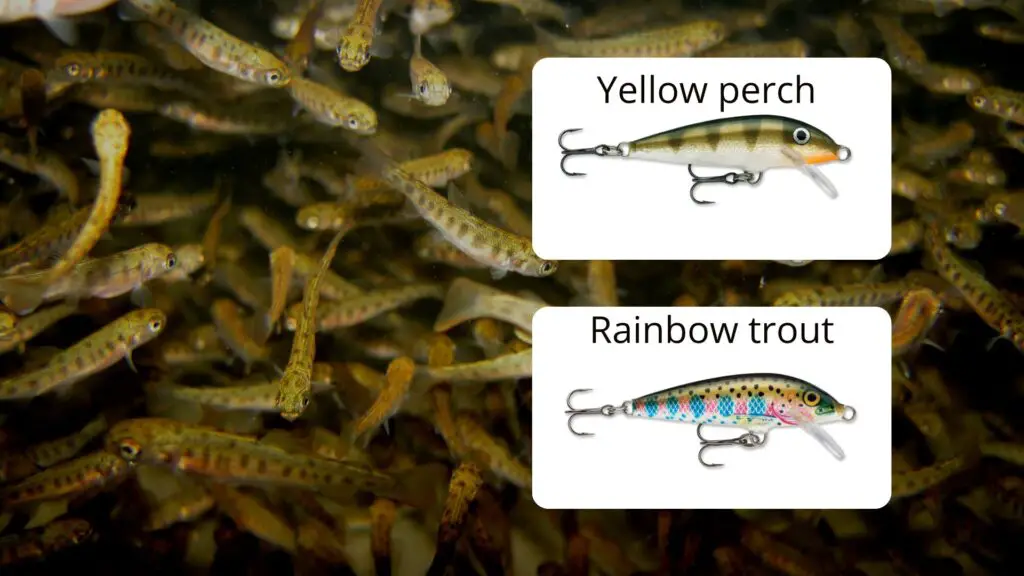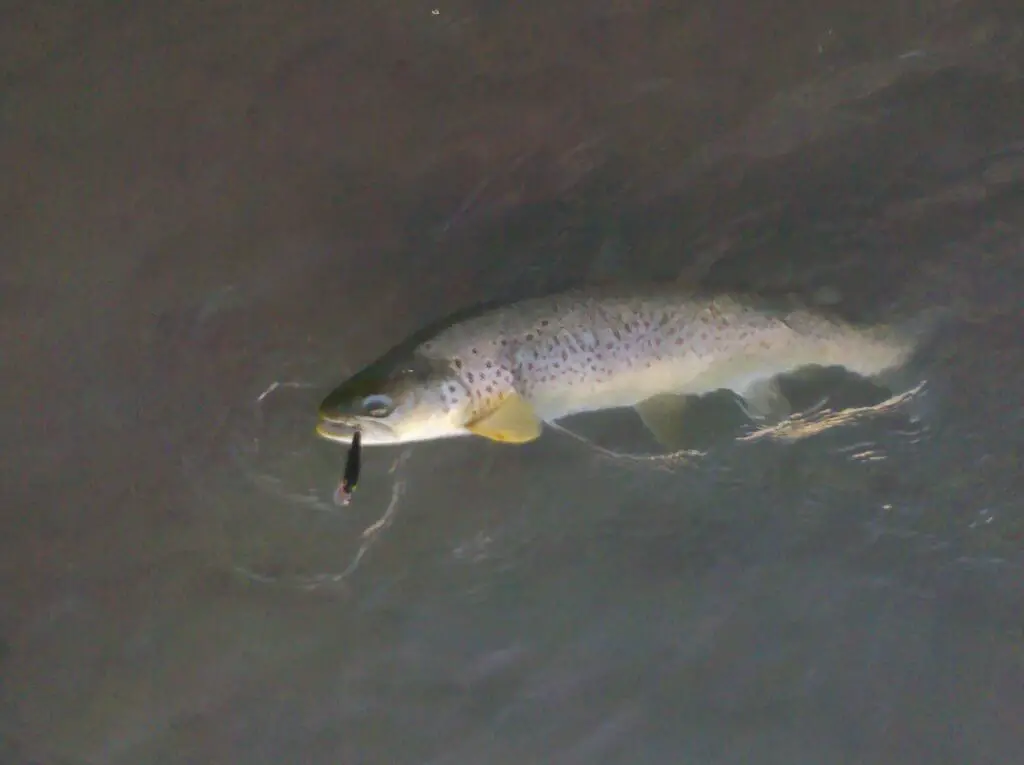I feel like the Oringal Floating Jerkbait needs no introduction. They have been catching trout for longer than most of us have been alive. A truly iconic trout lure, and despite countless new designs and innovations, no other jerkbait can consistently outfish the original.
The Rapala action is so iconic and effective at catching trout, that some fly tyers have even attempted to imitate it with highly specialized streamer designs such as the Wiggle Bugs and Minnows. Easier just to fish the real thing if you ask me.
I always carry multiple floating Rapala’s in my tackle box.
The floating Rapala catches nearly everywhere they live. They work extremely well from the shallowest of streams to the broadest of lakes. They are not only a top casting lure but also an excellent option to troll with.
Which color Rapala is best for trout fishing?
In my experience all color Rapala’s work well under the right conditions. What is most important is to fish the color or patterns you have the most confidence in.
In saying that, I still have my own preference. If I could only fish two colors it will be Yellow Perch and Gold Fluorescent Red. I will explain why.
I fish the Yellow Perch Rapala pattern to imitate trout fry. To my eyes, the yellow perch pattern much more closely resembles a young trout than the trout-specific patterns such as the brown trout or rainbow trout patterns. It also makes for a great generic baitfish pattern.
I have attached a photo below comparing rainbow trout fry with various color Rapalas. Notice how the Yellow Perch pattern closely resembles the pattern of the trout fry.

Hot Creek Rainbow Trout Fry, Rob Holm / USFWS – Public domain, via Attribution 2.0 Generic (CC BY 2.0))I am also a fan of the bright orange Gold Fluorescent Red pattern, simply because it is so bright and noticeable. I have found such a bright pattern works extremely well whenever water clarity is poor. If the trout can not see the Rapala, they are unlikely to take it.
How to fish Floating Rapalas
I love the versatility that floating Rapalas offer to my fishing.
Floating Rapalas are a type of jerkbait, but unlike the name, they do not have to be retrieved with a jerking motion.
When I target trout, I much prefer a slow steady presentation, much more representative of a crankbait retrieve. Trout are cautious feeders, they do not like the unexpected and an aggressively jerked bait can just as easily spook a trout as trigger them to strike.
This is why slow and steady generally outperform a more aggressive jerking retrieve. Now, if the trout are being stubborn do experiment and mix things up at times. Sometimes when the trout are feeding aggressively, strong jerks can be productive.
Fishing upstream
I nearly always prefer to fish upstream. I start at the bottom of the pool and cast slightly upstream and across the ripple. After casting, close the bail arm before the lure hits the water, this is because trout at times will take on impact and you must be ready to set the hook.
I retrieve the lure only slightly faster than the current. I systematically work my way up the ripple, concentrating on the most productive looking water, and only quickly covering the rest.
Productive spots include just upstreams of drop offs, eddys, current lines (look for white foam), submerged trees, and large boulders out in the flow. Trout also often choose to feed from the shade of overhanging trees.
Importantly do not forget to fish your feet and the extreme shallow. A large number of trout rest in the shallows just out of the current.
Do not stay in one spot for too long. I like to keep moving to give as many trout as possible a chance to strike. I can easily cover many miles a day fishing in this style.
I prefer to present my lure to two trout, rather than present it twice to a single fish. Trout are most likely to strike the first time they see a lure.
How to Fish a floating Jerkbaits downstream?
Sometimes, the only or best option is to fish downstream.
When fishing downstream, I often allow the current to carry my lure much farther than I could ever hope to cast it. I prefer to use braid when floating downstream, because it floats and will not end up sinking and snagging.
Do this by casting the lure into the main flow, but this time leave the bail open and allow it to float away. When floating like this it is extremely unlikely for a fish to take it. I can not remember it happening with any frequency.
Once the jerk bait is the desired distance downstream. Close the bail arm.
You now have two options.
Option 1 is to just suspend the lure, and rely on the current to hold it in place. Using this technique it is even possible to position a lure close to undercut banks or under overhanging vegetation.
Option 2. Is to slowly retrieve the lure like normal. Because you are fighting against the current, I always try to retrieve slow. Give the trout plenty of time to inspect and strike. It is coming in the wrong direction afterall.
This downstream technique is also very effective when trout are gathering at a river mouth outside of casting distance.

How to Fish a Floating Rapala Beneath Overhanging Branches?
For this technique, I prefer to use braid or some other type of superline because it floats on the surface. I prefer using Berkley Fireline.
Trout often feed beneath the cover of overhanging vegetation. Sometimes the branches are so close to the water surface making casting impossible.
In this situation, it is possible to use the current to carry a floating rapala beneath streamside vegetation. This is done by casiting out into the current, and closing the bail arm. Then the lure floats with the current but pivots around where you are standing.
Eventually, they pivot around enough to be directly downstream and parrael to the bank. Once in position, retreive the lure so it swims deep enough to get beneath any branches which are below the surface.
Some lures are lost using this technique, but I am caught some very big trout that will be impossible to target otherwise.
How to Fish Jerkbaits Around Submerged Trees?
Want to fish both sides of a submerged tree or a big raft of water weeds?
This is the technique I use to catch trout in such a situation. Cast your floating Rapala over the obstacle you wish to fish. Aggressively wind your reel to dive the Rapala down quickly. Then slowly and carefully retrieve the lure towards the structure.
Just before hitting the structure, pause and allow the Rapala to float to the surface. Then even more carefully float it across.
If you are fishing around weed beds, then they often grow on the surface. In such a situation, I carefully will remove all slack from the line, then quickly flick the lure back towards me and hopefully fly it across the surface. This does take a lot of skill and practice to do correctly.
I resume my retrieve once my Rapala is on the other side.
Floating Rapala’s are a top trolling lure for trout.
If I have to pick my favorite trolling lure, it will have to be the floating rapala. I have lost count the number of trout I have caught on them.
Floating Rapala’s are a excellent trolling lure where the water is relatively shallow, or when the trout are holding close to the surface. So I nearly always fish them when trolling close to shore, or in large rivers.
The larger the size of the Rapala, the deeper they tend to dive. So by changes sizes does allow some flexibility in the trolled depth. In extremely shallow water, I usually choose to troll a F05, where I suspect trout are holding deeper but still within about 6-8ft of the surface I will troll a F09.
One time I do no fish Rapalas is when I suspect the trout are holding deeper than 10ft. This usually happens during warm water conditions in the summer. While it is possible to use a downrigger or add weight, I prefer to keep my rigging simple and just troll a metal spoon instead.
Go slow, when trolling for trout
Unless you are stationary in the water, or getting blown backward by the wind is nearly impossible to troll to slow when targeting trout. (Trolling too fast, check my guide here on how to slow down a boat)
When trolling, I always monitor the tip of my rod for slightly vibrations. When a rapala is swimming correctly, it generates small vibrations that cause the rod tip to wobble.
I advise going no faster than 2 miles per hour when targeting trout, and for much of the year try to stay between 0.5 and 1 mile per hour. For more advice on the best trolling speed for trout check my guide here.
One useful trick to know, is if the water suddenly becomes shallow, the slow down even more and it will cause the floating rapala to raise close to the surface. I use this trick quite often, to prevent my Rapala’s from snagging on submerged branches.
How far behind the boat to troll?
The further the better to be honest. Boat sounds can scare trout, and the more distance between the boat and lure the better.
With that said, I typically troll with approximately 50 yards of line out. I also advise to troll in a lazy S pattern, this way the lure will always cut the corners and will travel over less disturbed water.
Which size Rapala is best for trout fishing?
Floating Rapala minnows come in a wide range of sizes. From the tiny F03 or the way up to the massive F18, but 99% of trout anglers will use lures between F03 and F09 in size.
The best size Rapala lures for trout fishing is between F05 and F07. With F03 and F09 having situational uses. I will describe each in more detail below.
While I do not doubt, at times trout will take the larger sizes, the smaller ones are generally more effective.
Firstly a quick tip. The model number indicates the length of a Rapala lure in centimeters. So a F05 is 5cm long, a F09 is 9cm long. If you are more familiar with imperial measurements, I included a chart below.
The chart below shows the sizes.
| Length (inch) | Length (cm) | Weight (oz) | Weight (g) | |
| F03 | 1-1/2″ | 3 | 1/16oz | 2 |
| F05 | 2 | 3 | 1/8oz | 3 |
| F07 | 2-3/4″ | 7 | 1/8oz | 4 |
| F09 | 3-1/2″ | 9 | 3/16oz | 5 |
| F11 | 4-3/8″ | 11 | 3/16oz | 6 |
| F13 | 5-1/4″ | 13 | 1/4oz | 7 |
| F18 | 7″ | 18 | 11/16oz | 21 |
Weights are approximately and some rounding has been applied. For example, the F05 weighs slightly under 1/8oz while the F07 is slightly heavier than a 1/8oz.
Is 03 Size Rapala good for trout fishing?
The 3cm long F03 size Rapala is an effective trout lure, but its small dimensions does limit its usefulness on larger waters. Best suited for targeting small fish in shallow streams and creeks where short precise casts are required. I also find the F03 has an extremely fast wobble which does not really look like an escaping baitfish.
For these reasons, I only consider the F03 size in niche situations, and nearly always prefer the F05 size over it.
Is 05 size Rapala good for trout?
The F05 size Rapala is an excellent size for targeting trout in most streams, rivers and ponds. It has a very effective action and is an excellent choice for working lake shores or the margins of larger rivers.
I will choose to fish the 05 size over the 07 when the trout are particularly small or wary.
Is 07 size Rapala good for trout?
Another excellent size, I feel the action is even more refined and to my eyes atleast seems very fishlike. The 07 rapala is my favorite size for nearly all trout fishing situations. It also casts slightly further than the smaller F05 making it slightly better for larger water.
Is 09 size Rapala good for trout
At 9cm long the 09 size Rapala is a bit large for trout, although I have had even relatively small trout take them. I use this size Rapala when I need to cast slightly further or if the water is a little discolored and I suspect the trout will struggle to see a smaller size.
Summary
Floating Rapalas are an excellent jerkbait for targeting trout in streams, rivers and lake margins. They are also an extremely effective trolling lure when the trout are holding close to the surface.
Due to the poor casting distance, they are not the best option for covered large amounts of water fast.
With the correct technique, and taking the advantage of its inherent buoyancy they fish extremely well around structure.

